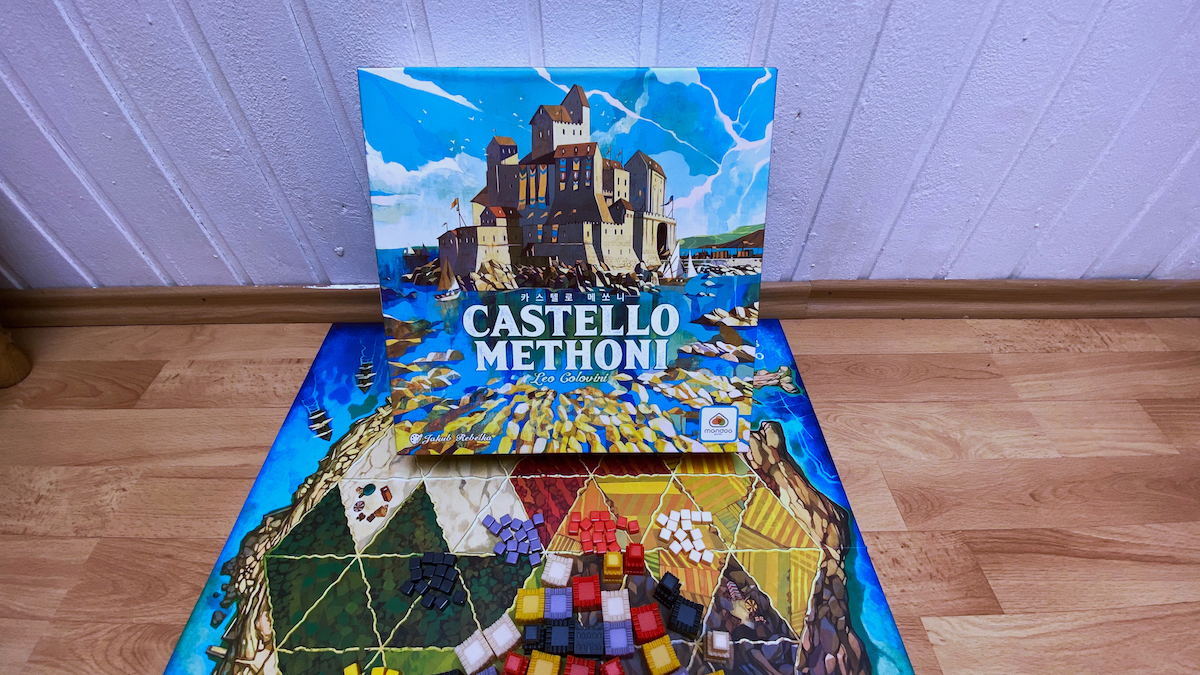Methoni is a village located in Peloponnese, Greece. It was a very strategic location for the merchants from Venice to penetrate the eastern market back then. Thus, in 1209, they built the fortified city in this area which is called in Italian, Castello Methoni (or The Castle of Methoni in English) until now. Although it’s mostly ruined, this castle is still considered as the pearl of the Byzantine Empire.
A short disclaimer before you read my board game analysis
As an avid euro gamer and hardcore Legend of the Five Rings (L5R) LCG player, my reviews may reflect a preference for these styles, and I may not cover solo games/variants extensively. Please note that my personal remarks are based on my gaming experiences, and I aim to provide honest insights within the scope of my preferences.
The game overview
Castello Methoni accommodates 3-5 players and it will need you to invest approximately 40 minutes to play. Castello Methoni is designed by Leo Colovini and published by Mandoo Games. We have covered some of their games in our blog, though! Behind the scene was Vincent Dutrait who’s responsible for the art and graphic design.
Summary of the rules
I will not go into details with this. If you haven’t read the rules, you can find it here.
First of all, you guys need to set up the board and the components. The number of walls used in the game depends on the number of players. You then need to distribute the Land cards and one Objective card per player.

During your turn, you can either Build or Trade by playing up to 2 Land cards. The Build action lets you to erect a wall between two spaces and to place one House of yours and your opponent’s (sitting directly on the left or right) on both sides of the wall. While doing so, when you close spaces with walls, you create a Domain. This is done by paying the cost, doing an Upgrade (Houses to Villas), and building your Tower on it. Anyway, these steps are all mandatory. You can also Annex the Domains adjacent to yours.
You may gain two Ducats (the currency in Castello Methoni) from the Market area with Tower by doing the Trade action. Please be aware that all components in this game are limited.
The game ends when all walls are depleted. Lastly, you need to count all the Victory Points (VP) you have gathered. Whoever gets the most is the winner. There’s a tie-breaker but you may also share the victory.
Opinion on Castello Methoni
I enjoyed Castello Methoni, graphics- and gameplay-wise. It is really streamlined and simple and your eyes will be spoiled by the artworks on the board and cards. Most sessions were short yet entertaining. Nothing changed with the alteration of player counts except the duration so I think it really depends on how much time you can spend (more players mean more minutes you need to invest). Let’s dig in to get more details here.
My first impression: “Oh, it’s a family game!”
To be honest, this game really took my entire gaming group by storm when Mandoo Games lifted the curtain for its release. I mean, let’s be honest, the lively colours that shape the game and those tiny components, who can resist such beauty? Most bright and vibrant colours usually decorate family games to attract younger crowds, so I really assumed that Castello Methoni will be another euro, family-friendly game.

Now, the rulebook
It is an 8-page-rulebook full of texts and images. They illustrate the how-to and cases you might find during the game. The rulebook is really concise as there aren’t many rules to convey in this game (just like I said, it’s actually a very easy-to-learn game). The layout is neat and it doesn’t jump around in order to help you comprehend the rules faster.
Playing Castello Methoni
After taking the role as the Venetian merchant, I’d like to reconsider my first impression of this game.
… I was wrong, really!
The game is far from the terms “friendly”. Yes, I said it’s light, quick, and easy to learn; but this game is rather malevolent due to its competitive nature. At some points, you’ll feel how ruthless the Venetian merchants can be in Castello Methoni.
Illustrate this: you would build the wall, hang out with your neighbouring Domains. The next turn, someone crushed the wall and annexed the domain you have just built and tore down your Tower.

If you think it’s okay, then let me tell you: the game mechanic, area control, dictates you to dominate the spaces on the board and it rewards you handsomely with 3 VPs per space inside your Domain. When someone annexed the domain and expanded his/hers, it would be a potentially huge loss for you.
Needless to say, Castello Methoni can be really intense!
Depending on cards in hand

Your actions really depend on what cards you have in hand to control spaces and to gain money. It does not necessarily mean that everything in this game is solely relying upon luck, but it would annoy you frequently when you couldn’t draw the card you need. This may lead to a big swing between players.
Still more strategic than tactical
Castello Methoni needs you to devise your plan and predict what your opponent will do in the future turns. It may be contradicting with what I wrote about the reliance upon luck (by drawing the cards), but this luck aspect is pretty minor in the game. It sure hangs on your fortune but you have to carefully pave your way based on what you have on hands.
The limited resources also force you to be cautious. You can’t gain Ducats when there’s none left in the bank, for example. This might be frustrating for some players and you should also need to adapt quickly based on what’s happening on the board. This also brings out Castello Methoni as an economy game.
And because it’s an economy game, it’s really good if you can control the market area as soon as possible. It gives you a Ducat when you are the first player to erect a Domain containing the market and two Ducats whenever your turn is up! This is really important mid- to end-game when you want to annex domains because it does cost a lot of Ducats.
What really draws my interest

High replayability through the randomised Land and Objective cards will give you other experience during each session. Also, the high interaction between players (although this is not really a Take-that kind of game) is really palatable for me. Perhaps it’s just my bias because I am not really into a zen-game.
The limited resources is also another good point I’ll give for Castello Methoni.

What feels off for me
Hmm… Hard to tell. I feel this game is really interesting and smashing. Nothing feels out of place. The only thing I don’t like is the downtime to calculate the cost when creating or annexing Domains but that’s really just my very personal laziness!
Final words
Castello Methoni will be a lovable experience for those who like classic euro. The game is really simple to learn but it still has that depth. It radiates a similar vibe when you play Catan, I guess? I am not exaggerating but despite its flaw, this game will get many loves from the gamers; and we might be even looking at the future classic board game.
TL;DR Castello Methoni will entertain most euro game lovers. It’s easy and fast yet mean. I can recommend.
I am a full-time food technologist during weekdays. However, when the calendar hits weekends, I transform into an avid board gamer. I am a hardcore Legend of the Five Rings (L5R) LCG player from Fantasy Flight Games (FFG). Current hobby: buying board games. My shelf of shame’s list is getting longer, thanks to you, Kickstarter.





